Design of a 2T1R-Type Parallel Mechanism: Performance Analysis and Size Optimization
Abstract
:1. Introduction
2. Type Synthesis and Structural Evolution
3. Mechanism Description and DoF Calculation
- l1: the length of the connecting rod A1B1, l2: the length of the vertical rod B1B11, l3: the length of the vertical rod C1D1.
- h1: the moving distance of the prismatic pair A11B11, h2: the moving distance of the prismatic pair A22B22, h3: the moving distance of the prismatic pair A3D3.
- c: the distance from the moving platform P to D1.
- a: the distance of OA1, i.e., the abscissa of A1 in the static coordinate system.
- d: the distance of OA2, i.e., the abscissa of A2 in the static coordinate system.
- e: the abscissa of A3 in the static coordinate system.
- f: the ordinate of A3 in the static coordinate system.
4. Kinematics Analysis and Numerical Simulation Verification
4.1. Inverse Kinematics
4.2. Jacobian Matrix
4.3. The Verification of Inverse Kinematics and Jacobian Matrix
5. Performance Analysis
5.1. Workspace
- (1)
- Constraint
- (a)
- Constraint of link-length
- (b)
- Constraint of the angle of actuating rod
- (c)
- Travel constraint of the prismatic pair
- (d)
- The interference of adjacent rods
- (2)
- Comparison to 3-PRR workspace
5.2. Stiffness Modeling
5.3. Dexterity Analysis
6. Size Optimization
6.1. Evaluation Standard
6.2. Optimization Process
7. Conclusions
- (1)
- A planar 3-DoF (2T1R) parallel mechanism is derived by structural evolution from the parallelogram by means of Grassmann line geometry and the Atlas method. The key property of the mechanism is that the two branches are designed as parallel closed-loop structures. The overall mechanism has the characteristics of high stiffness and large carrying capacity.
- (2)
- The position equation of the mechanism is established and the inverse kinematics and Jacobian matrix are investigated. The maximum deviation between the theory and simulation results of the inverse kinematics and Jacobian matrix is 0.48%, which verifies the accuracy of the theoretical model. Based on the results of inverse kinematics, the workspaces of the mechanism can be produced. The ratio of the workspace to the entire triangle space is about 15% higher than that of the 3-PRR parallel mechanism.
- (3)
- Based on the Jacobian matrix, the performance indexes are established to evaluate the stiffness and dexterity of the mechanism. Finally, the genetic algorithm is used to optimize the size of the rods to improve the comprehensive performance of the mechanism.
Author Contributions
Funding
Institutional Review Board Statement
Informed Consent Statement
Data Availability Statement
Acknowledgments
Conflicts of Interest
References
- Zhang, Q.X.; Chen, W.H. A review of the research progress of heavy-duty handling robots. Sci. Technol. Innov. 2021, 100–101, 105. [Google Scholar]
- Jin, X.; Fang, Y.; Zhang, D.; Gong, J. Design of dexterous hands based on parallel finger structures. Mech. Mach. Theory 2020, 152, 103952. [Google Scholar] [CrossRef]
- Qu, H.; Hu, L.; Guo, S.; Li, S. Statics analysis of a planar parallel mechanism with kinematic redundancy and closed-loop limb. J. Cent. South Univ. (Sci. Technol.) 2020, 51, 2758–2771. [Google Scholar]
- Li, X.; Li, R.Q.; Li, H.; Ning, F.P. A numerical solution of coupler curve and orientation for reconfigurable single-driven 3-RRR planar parallel mechanism. Acta Armamentarii 2021, 42, 1074–1082. [Google Scholar]
- Ganesh, M.; Bihari, B.; Rathore, V.S.; Kumar, D.; Kumar, C.; Sree, A.R.; Sowmya, K.N.; Dash, A. Determination of the closed-form workspace area expression and dimensional optimization of planar parallel manipulators. Robotica 2017, 35, 2056–2075. [Google Scholar] [CrossRef]
- Yang, H.; Guo, H.; Wang, Y.; Liu, R.; Deng, Z. Configuration synthesis of planar folded and common overconstrained spatial rectangular pyramid deployable truss units. Chin. J. Aeronaut. 2019, 32, 1772–1787. [Google Scholar] [CrossRef]
- Liu, W.; Liu, H. Synthesis of asymmetric parallel mechanism with multiple 3-DOF motion modes. Adv. Mech. Eng. 2022, 14. [Google Scholar] [CrossRef]
- Li, L.; Fang, Y.; Yao, J.; Wang, L. Type synthesis of a family of novel parallel leg mechanisms driven by a 3-DOF drive system. Mech. Mach. Theory 2022, 167, 104572. [Google Scholar] [CrossRef]
- Xie, F.; Li, T.; Liu, X. Type synthesis of 4-DOF parallel kinematic mechanisms based on Grassmann line geometry and Atlas method. Chin. J. Mech. Eng. 2013, 26, 1073–1081. [Google Scholar] [CrossRef]
- Liu, X.J. The Relationships between the Performance Criteria and Link Lengths of the Parallel Manipulators and Their Design Theory. Ph.D. Thesis, Yanshan University, Qinhuangdao, China, 1999. [Google Scholar]
- Xu, T.; Wu, J.; Zhang, B. Optimization design of a novel 4-DOF parallel manipulator. In Proceedings of the 2019 IEEE 9th Annual International Conference on CYBER Technology in Automation, Control, and Intelligent Systems (CYBER), Suzhou, China, 29 July–2 August 2019; pp. 963–968. [Google Scholar]
- Zhao, F.Q.; Guo, S.; Xu, Z.C.; Dian, L. Design and analysis of high performance machine tool based on redundant parallel mechanism. J. Cent. South Univ. (Sci. Technol.) 2019, 50, 67–74. [Google Scholar]
- Kong, M.; Chen, L.; Du, Z.; Sun, L. Multi-objective optimization on dynamic performance for a planar parallel mechanism with NSGA-II Algorithm. Robot 2010, 32, 271–277. [Google Scholar] [CrossRef]
- Zhang, D.; Wei, B. Stiffness Analysis and Optimization for a Bio-Inspired 3-DOF Hybrid Manipulator; Springer International Publishing: Berlin/Heidelberg, Germany, 2017. [Google Scholar]
- Huang, G.; Guo, S.; Zhang, D.; Qu, H.; Tang, H. Kinematic analysis and multi-objective optimization of a new reconfigurable parallel mechanism with high stiffness. Robotica 2017, 36, 1–17. [Google Scholar] [CrossRef]
- Xie, F.; Liu, X.J.; Wang, C. Design of a novel 3-DoF parallel kinematic mechanism: Type synthesis and kinematic optimization. Robotica 2015, 33, 622–637. [Google Scholar] [CrossRef]
- Yu, J.; Li, S.; Su, H.-J.; Culpepper, M.L. Screw theory based methodology for the deterministic type synthesis of flexure mechanisms. ASME.J. Mech. Robotics. 2011, 3, 031008. [Google Scholar] [CrossRef]
- Liang, D.; Zhang, Z.J.; Chang, B.Y. A novel SCARA parallel mechanism with double parallelogram branches. Trans. Chin. Soc. Agric. Mach. 2022, 53, 422–434. [Google Scholar]
- Li, Y.Q. A Heavy-Duty Sensitive Ball-Type Universal Wheel. CN202011232266.0, 5 February 2021. [Google Scholar]
- Zhao, Y.Z.; Cao, Y.C.; Liang, B.W.; Zhao, T.S. Determination and synthesis of translational parallel mechanism with constant Jacobian Matrix. J. Mech. Eng. 2017, 53, 101. [Google Scholar] [CrossRef]
- Agheli, M.; Nestinger, S.S. Comprehensive closed-form solution for the reachable workspace of 2-RPR planar parallel mechanisms. Mech. Mach. Theory 2014, 74, 102–116. [Google Scholar] [CrossRef]
- Min, S.; Hong, Y.L.; Dong, J.-J.L. Workspace and dexterity optimization of 3-PRR planar parallel manipulator. In Proceedings of the 12th International Conference of European Society for Precision Engineering and Nanotechnology, Stocholm, Sweden, 4 June 2012; pp. 360–363. [Google Scholar]
- Wu, J.; Wang, R.; Wang, R. A comparison study of two planar 2-DOF parallel mechanisms: One with 2-RRR and the other with 3-RRR structures. Robotica 2010, 28, 937–942. [Google Scholar] [CrossRef]
- Rybak, L.A.; Gaponenko, E.V.; Malyshev, D.I.; Behera, L. Determination of the working area and singularity zones of the 3-RRR robot based on the non-uniform coverings’ method. J. Phys. Conf. Ser. 2019, 1353, 012057. [Google Scholar] [CrossRef]
- Yu, J.J.; Liu, X.J.; Ding, X.L.; Dai, J.S. Foundation of Mathematics of Robot Mechanism, 2nd ed.; China Machine Press: Beijing, China, 2008; pp. 203–219. [Google Scholar]
- Gao, Z.; Zhang, D. Performance analysis, mapping, and multi-objective optimization of a hybrid robotic machine tool. Ind. Electron. IEEE Trans. 2015, 62, 423–433. [Google Scholar] [CrossRef]
- Zhang, C.; Wang, C.; Miao, Q. Two-Stage optimization of a reconfigurable asymmetric 6-DOF haptic robot for task-specific workspace. In Proceedings of the 2021 IEEE/RSJ International Conference on Intelligent Robots and Systems (IROS), Prague, Czech Republic, 27 September 2021–1 October 2021; pp. 8345–8351. [Google Scholar]
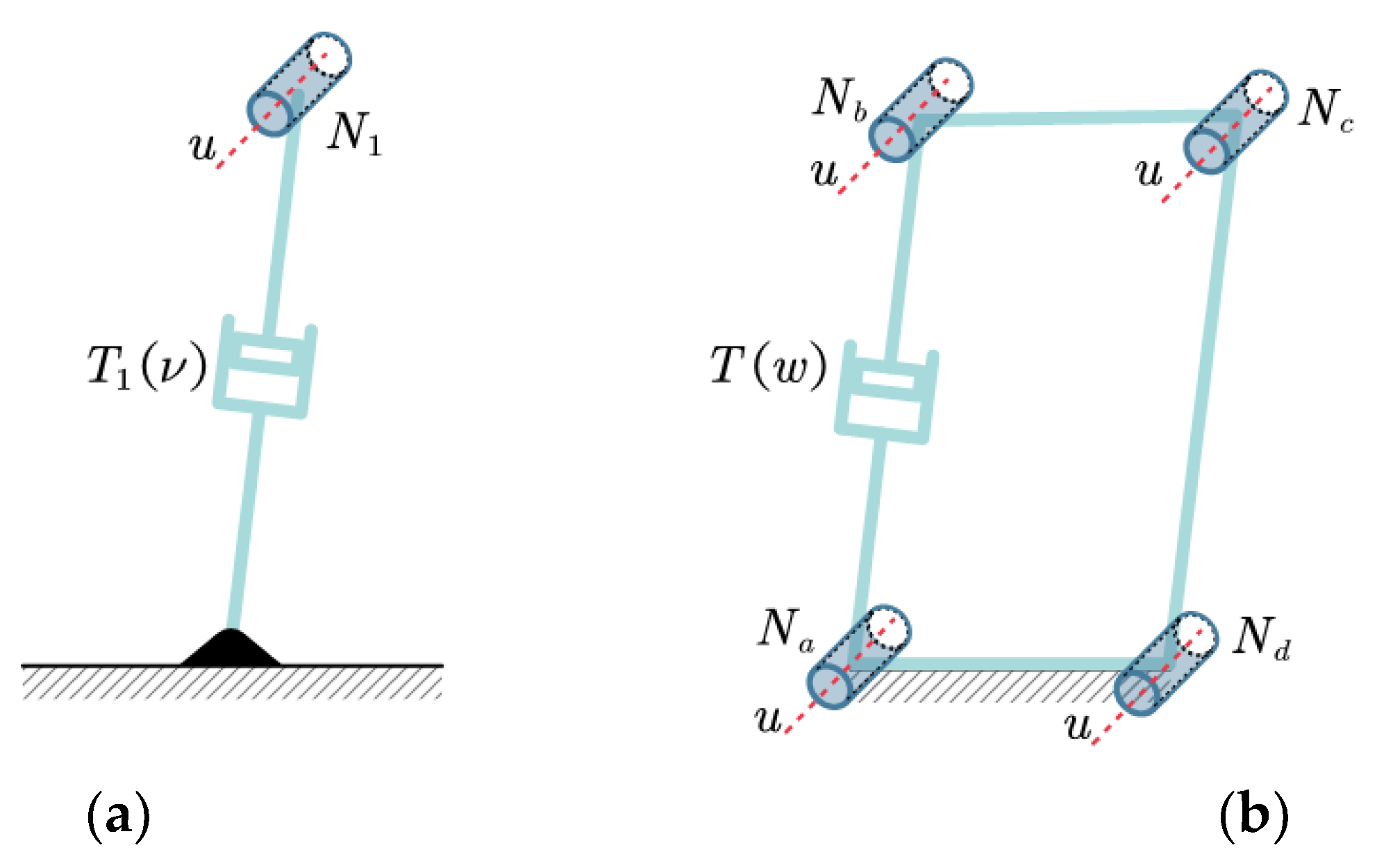
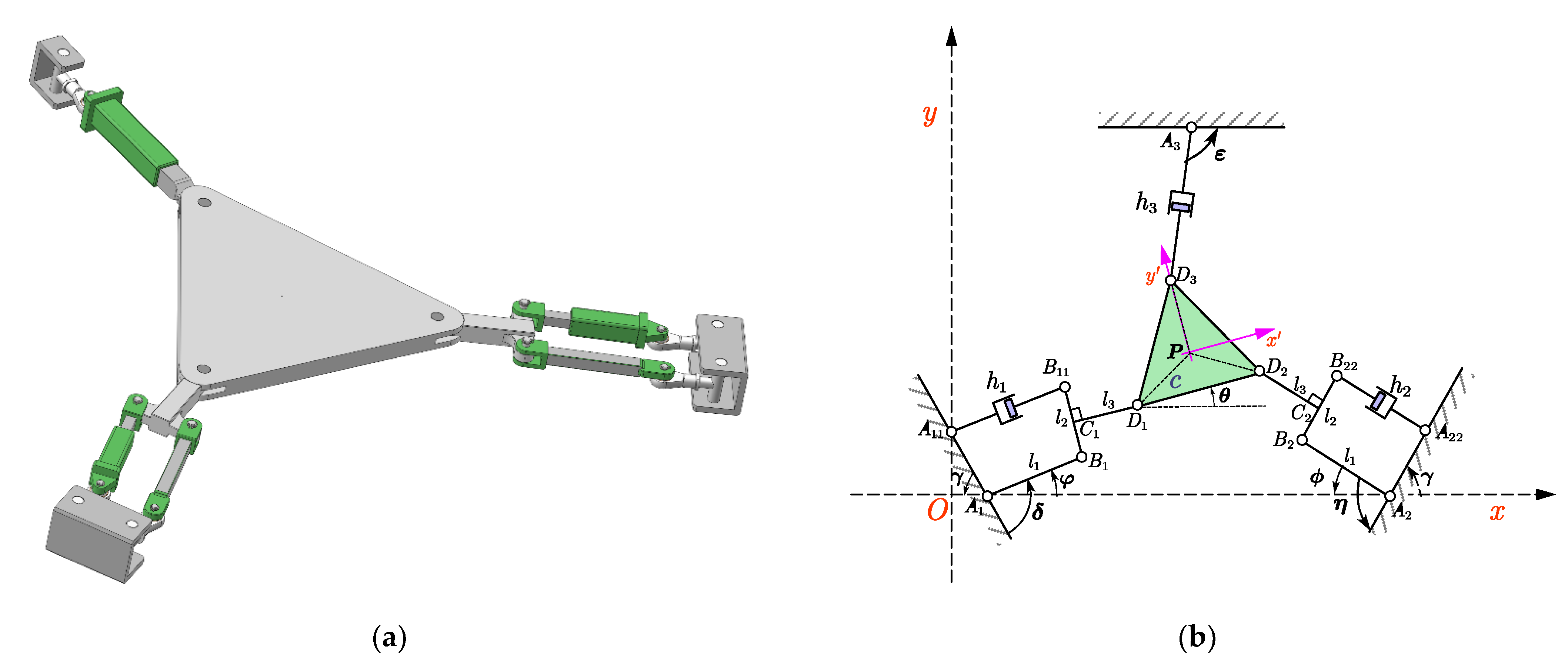



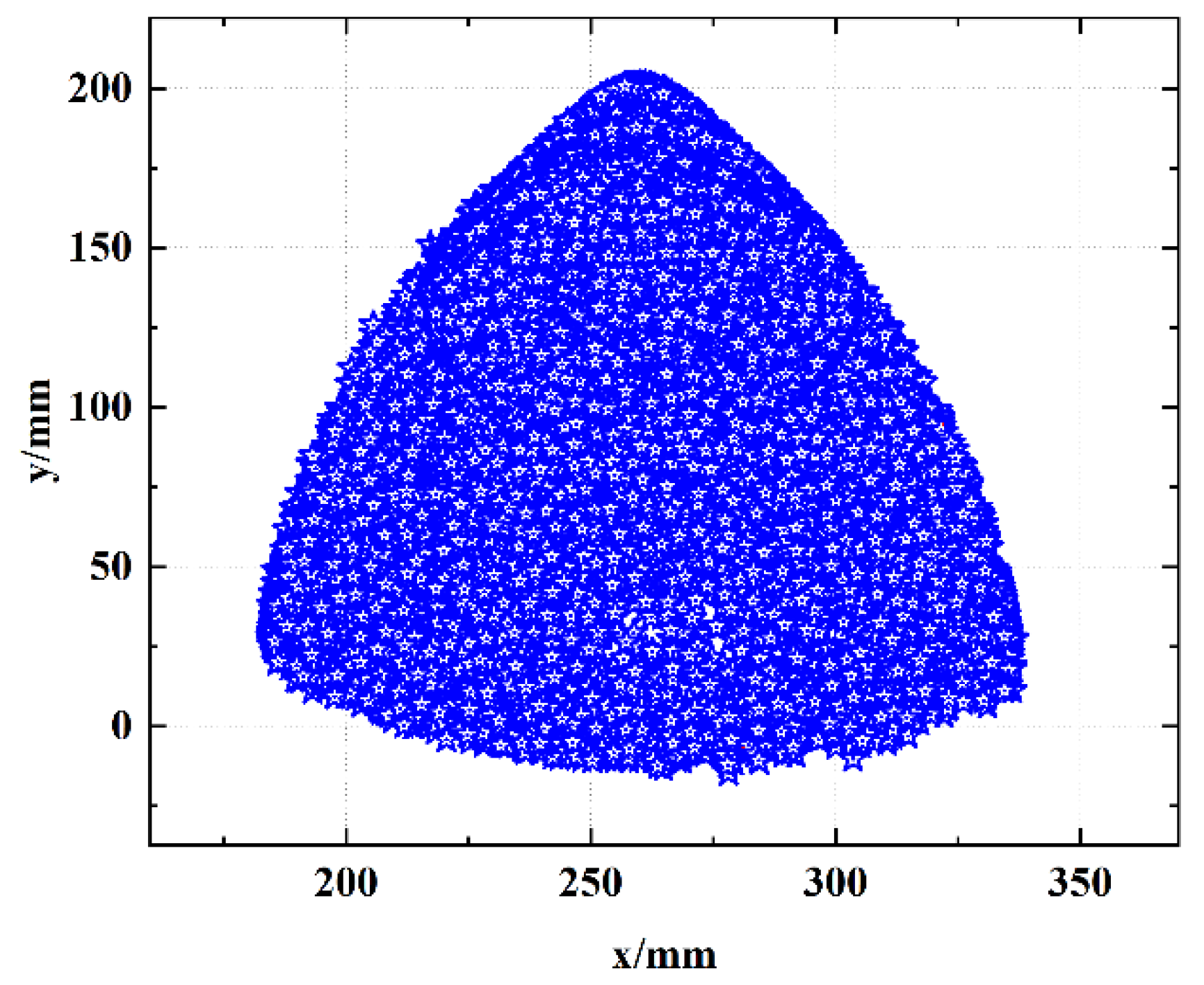
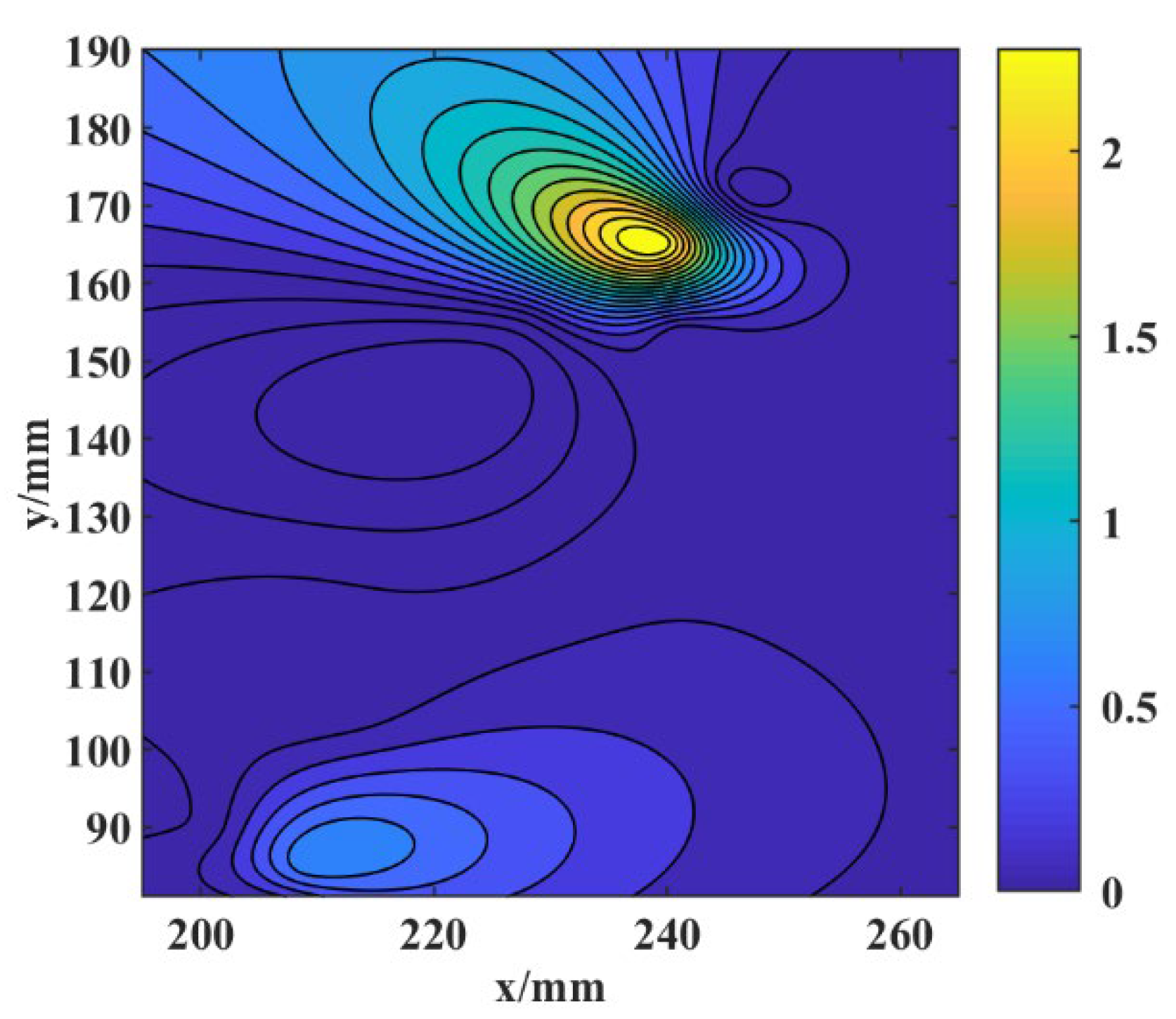
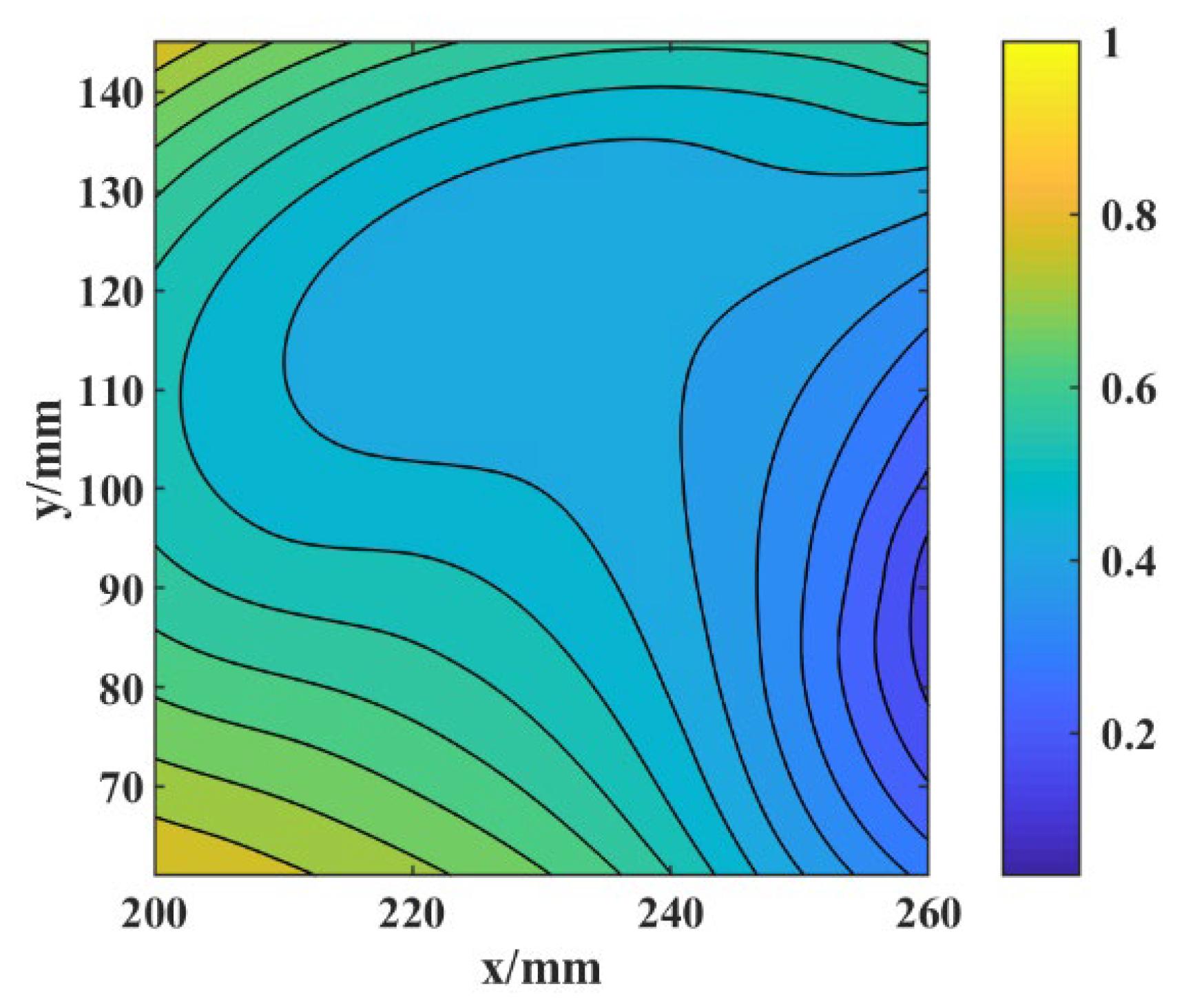

| Configuration | Constraint Space | DoF Space | Kinematic Chain |
|---|---|---|---|
| First limb |  One-dimensional force constraint and two-dimensional couple constraint |  Two-dimensional translations and one-dimensional rotation |  (RR-RPR)-R |
| Second limb | 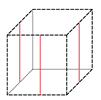 One-dimensional force constraint and two-dimensional couple constraint |  Two-dimensional translations and one-dimensional rotation |  (RR-RPR)-R |
| Third limb | 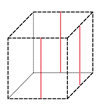 One-dimensional force constraint and two-dimensional couple constraint |  Two-dimensional translations and one-dimensional rotation |  RPR |
| Mechanism | 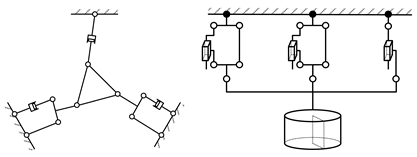 Two translational DoFs and one rotational DoF (  , ,  : Prismatic pair; : Prismatic pair;  : Revolute pair; : Revolute pair;  : Fixed point) : Fixed point) | ||
| Parameter | Value (mm) | Parameter | Value (mm) |
|---|---|---|---|
| 20 | 450 | ||
| 134 | 100 | ||
| 500 | 40 | ||
| 260 | 80 | ||
| h1 | (45, 135) | h2 | (45, 135) |
| Parameter | Minimum Value | Maximum Value |
|---|---|---|
| X | 177.75 mm | 341.22 mm |
| Y | −6.51 mm | 201.37 mm |
| 0° | 90° | |
| 0° | 97° | |
| 0° | 94° | |
| 115 mm | 331 mm |
| Variable | Constrants (mm) | Variable | Constrants (mm) |
|---|---|---|---|
| l1 | 70,150 | l3 | 50,100 |
| l2 | 3070 | c | 60,110 |
| Number | l1 | l2 | l3 | c | Number | l1 | l2 | l3 | c |
|---|---|---|---|---|---|---|---|---|---|
| 1 | 122.33 | 60.43 | 76.46 | 105.51 | 16 | 148.16 | 53.72 | 83.50 | 106.35 |
| 2 | 149.55 | 30.77 | 87.86 | 76.30 | 17 | 134.42 | 69.74 | 65.97 | 100.10 |
| 3 | 110.40 | 43.34 | 94.95 | 88.59 | 18 | 149.79 | 62.94 | 78.92 | 64.27 |
| 4 | 115.93 | 40.61 | 99.92 | 101.53 | 19 | 125.14 | 34.19 | 69.15 | 86.13 |
| 5 | 145.04 | 53.29 | 52.16 | 108.27 | 20 | 114.68 | 54.79 | 69.02 | 103.86 |
| 6 | 117.85 | 52.73 | 75.35 | 86.10 | 21 | 127.92 | 58.95 | 53.49 | 98.18 |
| 7 | 134.38 | 35.75 | 86.65 | 83.83 | 22 | 116.65 | 60.65 | 90.99 | 106.06 |
| 8 | 107.08 | 58.06 | 80.04 | 95.25 | 23 | 144.73 | 67.56 | 58.16 | 103.34 |
| 9 | 130.24 | 34.02 | 64.50 | 98.35 | 24 | 107.88 | 67.58 | 68.37 | 103.65 |
| 10 | 121.66 | 56.24 | 89.78 | 91.65 | 25 | 121.83 | 60.72 | 53.53 | 102.34 |
| 11 | 137.60 | 45.83 | 62.47 | 83.27 | 26 | 145.47 | 43.75 | 93.90 | 90.22 |
| 12 | 122.47 | 52.57 | 66.86 | 93.96 | 27 | 85.55 | 63.56 | 67.35 | 97.22 |
| 13 | 117.70 | 51.60 | 75.05 | 87.02 | 28 | 101.36 | 51.12 | 90.21 | 107.50 |
| 14 | 130.94 | 38.76 | 90.12 | 74.80 | 29 | 106.34 | 60.34 | 83.12 | 105.12 |
| 15 | 144.78 | 68.38 | 71.68 | 78.30 | 30 | 129.38 | 31.82 | 51.48 | 104.85 |
| No. | Value | No. | Value | No. | Value | No. | Value | No. | Value |
|---|---|---|---|---|---|---|---|---|---|
| 1 | 5.04 | 7 | 4.01 | 13 | 5.08 | 19 | 4.84 | 25 | 4.11 |
| 2 | 5.66 | 8 | 5.13 | 14 | 4.35 | 20 | 6.24 | 26 | 3.64 |
| 3 | 5.54 | 9 | 5.32 | 15 | 6.34 | 21 | 4.12 | 27 | 5.02 |
| 4 | 4.82 | 10 | 4.62 | 16 | 3.20 | 22 | 3.30 | 28 | 4.64 |
| 5 | 4.80 | 11 | 4.21 | 17 | 5.35 | 23 | 4.79 | 29 | 4.14 |
| 6 | 6.70 | 12 | 5.02 | 18 | 6.03 | 24 | 4.85 | 30 | 5.72 |
Publisher’s Note: MDPI stays neutral with regard to jurisdictional claims in published maps and institutional affiliations. |
© 2022 by the authors. Licensee MDPI, Basel, Switzerland. This article is an open access article distributed under the terms and conditions of the Creative Commons Attribution (CC BY) license (https://creativecommons.org/licenses/by/4.0/).
Share and Cite
Wang, D.; Zhang, J.; Guo, H.; Liu, R.; Kou, Z. Design of a 2T1R-Type Parallel Mechanism: Performance Analysis and Size Optimization. Actuators 2022, 11, 262. https://doi.org/10.3390/act11090262
Wang D, Zhang J, Guo H, Liu R, Kou Z. Design of a 2T1R-Type Parallel Mechanism: Performance Analysis and Size Optimization. Actuators. 2022; 11(9):262. https://doi.org/10.3390/act11090262
Chicago/Turabian StyleWang, Dongbao, Jing Zhang, Hongwei Guo, Rongqiang Liu, and Ziming Kou. 2022. "Design of a 2T1R-Type Parallel Mechanism: Performance Analysis and Size Optimization" Actuators 11, no. 9: 262. https://doi.org/10.3390/act11090262




